BY SUSAN KAUFFMANN
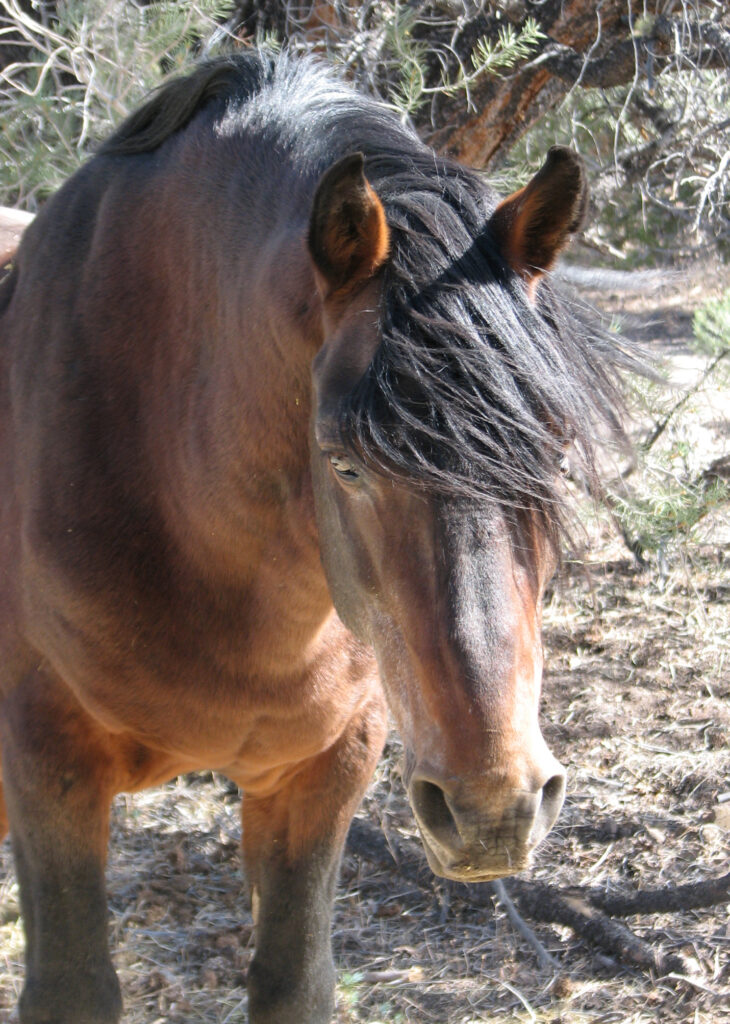
Ranger was a true King among horses, with a presence that left people changed for having known him.
When my husband Michael and I moved from British Columbia to California for his work, I had no idea that a few short years later, I would be living in wild horse country in the mountains outside of Reno, Nevada. I certainly could not have imagined that once there, I would end up adopting an ancient, special-needs wild stallion, nor could I ever have envisioned how many important lessons a horse that many people saw as “useless” had to teach me.
Our neighborhood is an amazing place where bands of wild horses roam at will, and you get so used to seeing them grazing, resting, playing and fighting all over the place that they become simply part of the scenery. “Ranger” stood out, however, as from the first moment I saw him, it was evident that this little bay stallion was in serious trouble. While the other mustangs in the area were vibrantly healthy and almost chubby after a particularly lush spring, Ranger was far too thin, his head hung down as if he didn’t have the strength to lift it, his eyes were crusty, saliva dripped from his mouth and he had several small swellings around his throat.
I spent some time watching him from a distance and observed that he was unable to chew any forage at all (he would try but would inevitably spit it back out in wads), and he seemed to be barely surviving by eating dried horse manure. This, along with the drooling and odd lumps, led me to believe that there must be something wrong in his mouth or throat.
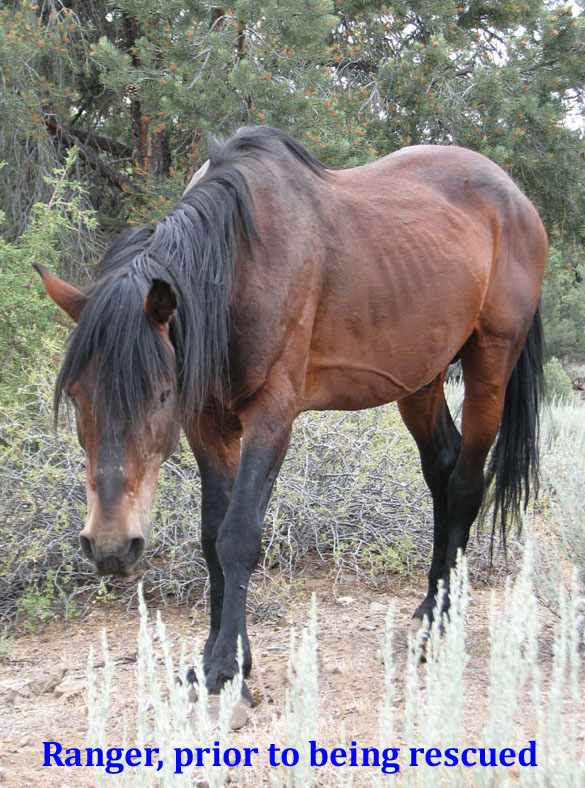
Ranger, the first time we ever saw him. He was so weak he could barely hold his head up.
Knowing what a slow and cruel death starvation is for a horse, I called the Nevada Department of Agriculture (NDA) and got permission for myself and several other volunteers to capture Ranger, the hope being that we could figure out what was wrong with him, fix the problem, then release him back onto the range.
Fortunately, capturing Ranger turned out to be the least dramatic “round up” in history. As he had gotten friendly with my miniature donkey, Rogie, and would often hang out with the little social butterfly through the fence, we built a catch pen out of horse panels in that area, put a pan of grass pellets inside it, and set up watch from inside the barn. Our hope was that Ranger would simply walk into the pen, then we would dash out and close the opening, and that is exactly what happened.
What was most surprising to me was that Ranger didn’t seem distressed about being enclosed. He was definitely wary of us and would keep as far away from humans as possible, but he didn’t pace the fence, call, or show any signs that being contained was upsetting to him. In fact, he seemed to enjoy his hot mashes, fresh water that he didn’t have to walk miles and miles to get to, and a soft area of shavings in which to lay down and rest.
However, once we had Ranger in captivity, we saw that he was quite old, and his teeth were either completely missing or worn down to the gums from what we could observe – not something that could be fixed. The NDA then gave us two options: I could keep him, see if he could be brought back to health, then find him an adoptive home, or their brand inspector would take him immediately and put him down. Obviously, this was not a horse that would ever be ridden or have a traditional “purpose,” but as he still had a strong will to live and seemed quite content with his new life, we decided to give him a chance.
The brand inspector and I estimated Ranger’s age to be at least 25, and when we took that and his very poor condition into consideration, all agreed that it was not safe to have Ranger gelded or branded, as the stress and blood loss could easily have killed him. Thus, a stallion he remained. At that point, I had no intention of keeping Ranger long-term myself, since Michael and I were in the middle of building both a new life and a new house, and I needed an old, toothless, completely untouchable wild stallion like a hole in the head. I was, however, willing to undertake Ranger’s rehabilitation, but only because I was sure that with the help of the local mustang advocacy groups who said they would assist in finding Ranger a permanent home, we would soon locate some kind angel or sanctuary willing to take him on.
Over the next couple of months, we fed Ranger four meals a day of a mix of grass pellets and low-carb senior feed, all made into a slurpable warm mash. While we initially had no idea whether he would be able to bounce back from his weak and wasted state, we were thrilled to see him getting stronger, gaining both fat and muscle, and slowly learning to take baby steps toward interacting with people.
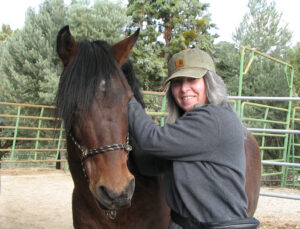
Ranger learning to wear a halter. It took some time to get to this point, but by never forcing anything on him that he wasn’t comfortable with, we accomplished things we had been told would be impossible.
Unfortunately, no angel adopter was ever found, and the sanctuaries wouldn’t take Ranger because he a stallion and because he required such specialized, expensive and labor-intensive feeding – so I became Ranger’s forever home by default.
At first, this seemed like an almost unmanageable burden with all that Michael and I had going on, but I now realize that what Ranger brought to my world over the four years that he graced me with his presence was an incredible gift. Having been a horse trainer most of my life, every other horse I had ever interacted with had come with a set of “requirements” in regard to what I needed to teach them, and they also came to me having already been shaped, by both breeding and handling, by humans. There was none of that with Ranger. He gave me the chance to experience what it is like to interact with the fully formed spirit of a horse who had been 100% free of human influence for his entire life, and to be free myself from any requirement to “make” this incredible being do anything.
Embracing that opportunity, I decided that whatever I did need to teach Ranger about life with humans would be done on his terms, using no pressure, no restraint and no force. If he didn’t like something, he could just turn and leave. Wow, what an education! He also taught me more than I knew existed about the complexities and subtleties of equine body language, as his own ability to speak that language had never been tamped down or muddied by humans. Before I started simply “being” with Ranger, I had not really given much thought to how much we commonly shut down the things our horses try to say. By demanding subservience and insisting upon completely unnatural spatial interactions, we not only disallow their self-expression, but we end up somewhat hampering their ability to “speak horse.”
Ranger, on the other hand, was crystal clear in his communications and subservient to no one. He had been a true King among horses – a vibrant herd stallion who bore the scars of many battles and who knew what the real world of being a horse was all about. He always maintained that air of wisdom and royalty, and it flowed all around him with an energy you could feel down to your bones.
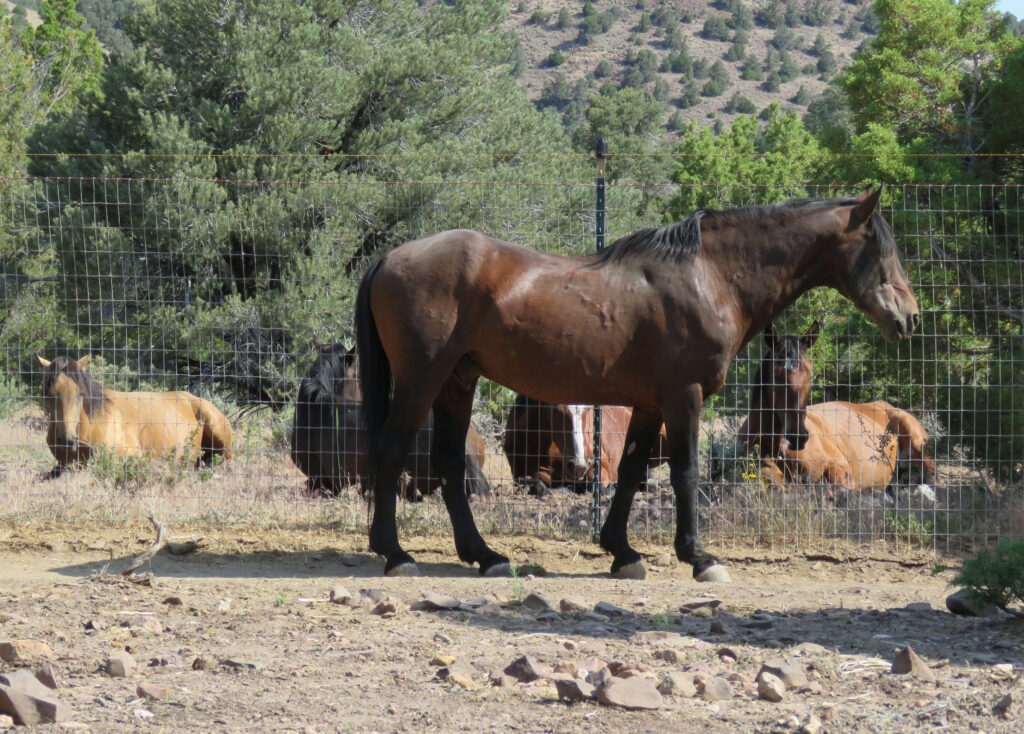
And it wasn’t just humans who were aware of this — other horses clearly felt it too. I will never forget the day I went outside and saw four young, wild, bachelor stallions laying down in a line just outside Ranger’s fence as he stood watch over them. The youngsters clearly felt safe in Ranger’s regal, self-assured, yet benevolent presence.
Ranger was indeed incredibly noble, as well as extremely expressive, telling me exactly what he thought about everything I did in no uncertain terms. That said, he never once made me fear for my safety, I think possibly because he knew I would listen to what he had to say, so he never felt the need to “shout” (kick, bite, etc.). There were moments when I’m sure he was frustrated with me (he would sometimes shake his head dramatically as if to say “No, no, NO! You’re just not GETTING it!”), but this was his way to communicate my ineptitude to me, never a threat.
He could also be surprisingly and adorably affectionate with me and the few other people he trusted, particularly our friend Dona, who had been part of the effort to save Ranger from the very beginning.
And despite remaining wild in many ways, he was willing to learn about things like being haltered and brushed – as long as you worked at his pace, broke everything down into very small pieces, and gave him plenty of releases and breaks. He even got to a point where I could medicate his chronically tearing eye, which made him much more comfortable. Every time I presented something new, I would ask him, out loud, “What do you think?” as I not only genuinely wanted to know, I also wanted him to know that his opinion mattered. He soon came to understand that he had at least an equal say in everything we ever did – and I think that made learning possible.
When I first took Ranger on, many people had told me that a wild stallion that age would be incredibly dangerous to work with and impossible to gentle, but that was not the case at all. I believe that by throwing any dominance-based ideas out the window and instead treating Ranger with the deep respect he both inspired and deserved, doors opened that would otherwise have been shut. Learning those lessons from Ranger has helped me become a better horseman, no matter what kind of horse I am working with, and I will be forever grateful for all that he taught me.
During most of the four years that Ranger was with us, he enjoyed vibrant health that was a testimony to his recuperative abilities, as well as to the almost unfathomable toughness of mustangs in general.
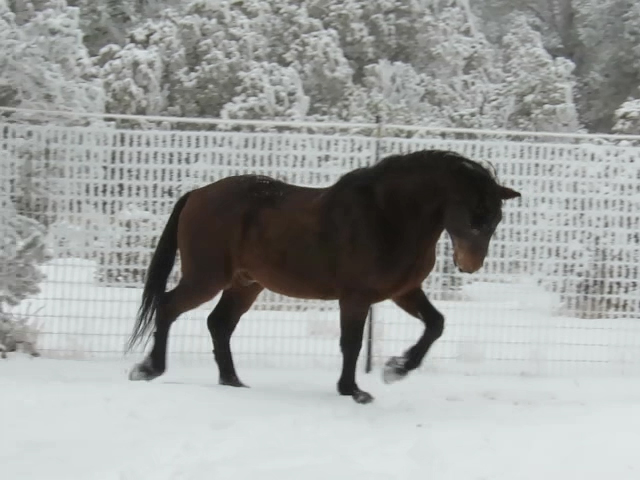
Ranger, around 30 years old, strutting his stuff in the snow and making sure we all knew that he was still as awesome as ever!
Then he started having repeated choking episodes that were as terrifying to me as they were to him, and even when he didn’t choke, he would often fail to finish his meals, which was extremely uncharacteristic. We brought in a vet, managed to get Ranger sedated, and discovered that he had a growth in his throat, as well as one unopposed molar left that the vet told us could eventually poke through his palate and could already be causing discomfort. Either the lump, the tooth or both could be causing the problems Ranger was having. He also had worsening Degenerative Suspensory Ligament Desmitis (DSLD) that the vet explained was probably a lot more painful than a stoic horse like Ranger let on. As all of these problems would only get worse, and we had no wish to put Ranger through painful surgeries that would be dangerous to even attempt, the decision was made to humanely euthanize him that day.
The grief I felt when Ranger left this world is something I cannot find adequate words to explain. It did indeed feel like the passing of a king, like the world had lost some great and noble presence and was now a lesser place because of it. I thought of the words of the great horse trainer, Josh Nichol, who had met Ranger once and who later said about him, “You just wanted to be near him and breathe him in. He was genuinely unlike any other horse I’ve ever encountered — meeting him changed me.” Ranger had changed me as well in many positive ways, but having known him and cared for him day in and day out for four years, his passing left a tremendous hole.
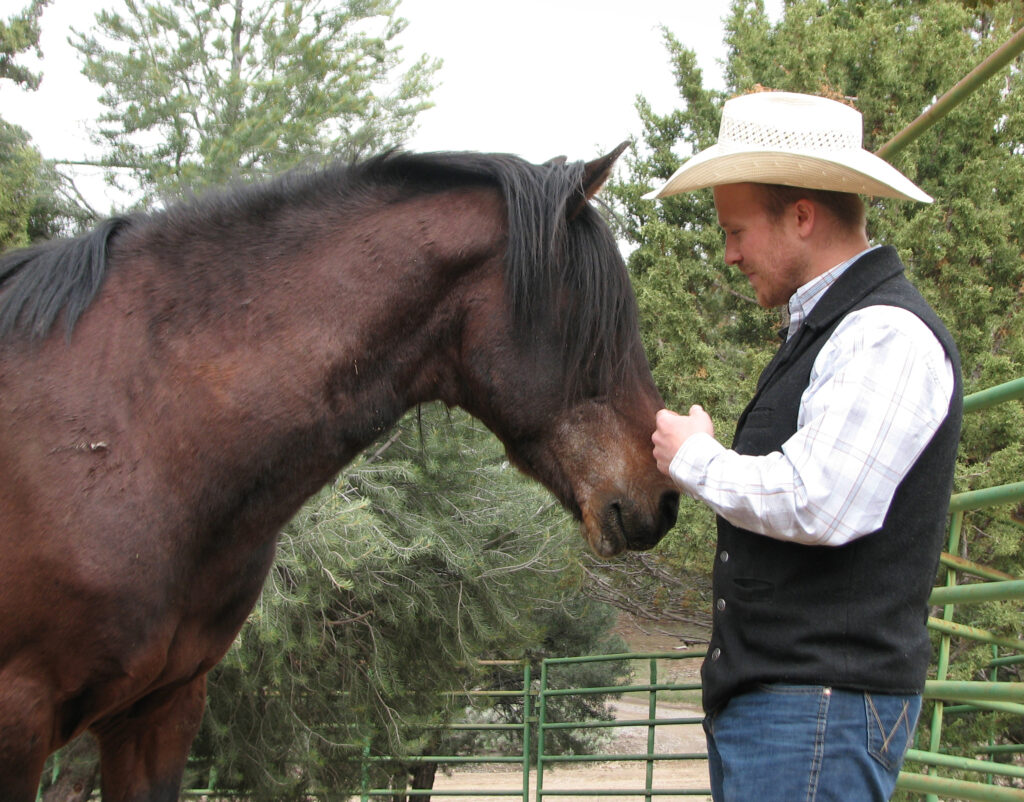
Ranger, pictured with the great Canadian horse trainer, Josh Nichol.
However, I then reminded myself that Ranger had been an extremely successful herd stallion, known in our area for many, many years. He didn’t just have offspring on the range, he had generations of offspring on the range, and all of them carry his remarkable spirit into the future. I take great comfort in that, and sometimes even see horses, wild and free and strong, that have Ranger’s beautiful face, with its soulful gaze and distinctive nasal bone structure, and I know they are his babies and grandbabies. I like to think that somehow, he is still out there watching over them — and maybe, just maybe, he also watches over me.